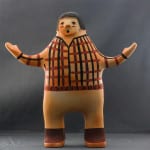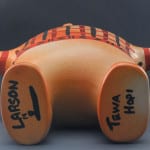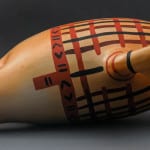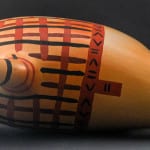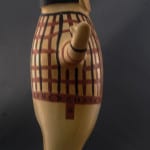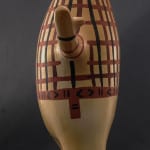11.313” h X 10.438” w (finger to finger) X 3.563” d (belly-button to back).
Slightly pudgy and wearing a mis-buttoned plaid shirt, this effigy appears to depict the owner of this collection of pottery, perhaps demonstrating the size of a Hopi pot that he failed to buy at auction.
I have met Larson only once (at a Hopi Show at the Museum of Northern Arizona), but he obviously found me inspiring.
Apparently, Larson carved this figure with an X-ACTO knife: “I feel a little like a kachina doll carver. I wet the whole thing down and shave the clay away” (Trimble 2007:17). Larson does not shy away from using advanced technology, employing bamboo skewers to hold up the outstretched arms of his figures: “It looks like they are skiing,” he says (Trimble 2007:19).
Variations in blushing indicate figure 2013-24 was traditionally fired outdoors. The open mouth provided a vent for hot gases to escape the hollow form. A square nose reflects the square cut of a traditional Hopi male haircut. A short red stripe is drawn beneath each eye.
Five horizontal light red lines and 26 vertical lines (alternating dark red and black) form the plaid of the shirt. The shirt was not buttoned correctly: horizontal lines of the shirt are dramatically mismatched at the front closure. Each arm is encircled by one black and two red vertical lines. Red and black print lines run from the shirt pattern horizontally along the man’s upper left arm. His right arm displays one red line that flows horizontally from the torso of the shirt and one short black line that connects to nothing. Before leaving home this morning, this guy did not look in the mirror.
A traditional woven sash is used as a belt with drapes at each hip. Dark red boots complete the outfit.
[For a 2006 photograph of Larson with a figure similar to 2013-24, see Trimble (2007:115).]
In 2008 Larson posted this biography online:
Name is Larson Goldtooth. I am 38 Years Old, A member of the Tobacco Clan. I come from Tewa Village which is located at First Mesa in Northeastern Arizona. I have been practicing the art of Hopi-Tewa Pottery for 13 years. Though I have been working with Native Clay for this time period, I am still considered an Emerging Artist. I learned the Art of Pottery Making from My Cousin Mark Tahbo. I first became interested by watching him build, paint and fire Pottery.
It wasn’t until 1996 that I entered my first Juried Show at the Museum of Northern Arizona where I received my first award in the Pottery Category. From that moment on, I knew I was given a gift that I could not give back and that’s when I decided to become one with the clay and the art of Pottery Making. I was taken thru many trials as I began learning the processes of making pottery. I started traveling. At the same time holding a full-time job and going to different Native Art Shows. I began receiving Awards and recognition for my work. In the beginning of my art career, It was my goal to show at the Heard Museum Fair. After that was accomplished, I set my sights on the Santa Fe Indian Market. I was accepted as a “New Artist” in 1999 and given a booth to show.
My art work took a turn at that point. I went from doing the Traditional Hopi shapes and designs, to making Clay Figurines. I was inspired by the late Helen Cordero of Cochiti Pueblo. I watched her make her seated Storyteller People with children on a video tape done by the Wheelwright Museum. Taking on that challenge was tough. Learning how to coil and fire proved to be difficult but, I did not give up. A few years later, I was inspired by Virgil Ortiz also from Cohiti Pueblo who was doing the Standing Figures. I told myself that I was going to take on the challenge of taking Hopi Pottery in a new direction. Around 2002, I entered my first Standing Figures at the Santa Fe Indian Market where I received my “first” First Place Ribbons.
What an honor and validation for me. I knew that what I was doing was going to eventually get noticed so, I kept building.
It is now 2008, I will be celebrating my 10 year Anniversary Showing at the Santa Fe Indian Market in August.
I have received numerous awards for my work. The most prestigious award in my career at the Santa Fe Indian Market was receiving the Fellowship Award in 2005. I left my job in August of 2007 to become a Full-Time Potter. My Figure People and my Pottery are done in the traditional Hopi method. That is, hand-coiling each piece, stone burnishing, using the color clay pigments and the wild mustard and bee weed plants to design each piece. After all that is complete, I fire outdoors with cedarwood and sheep dung before they are sent to market.


